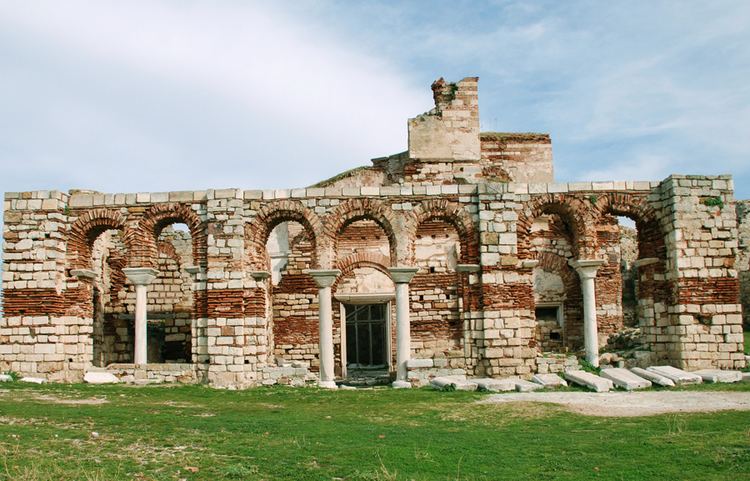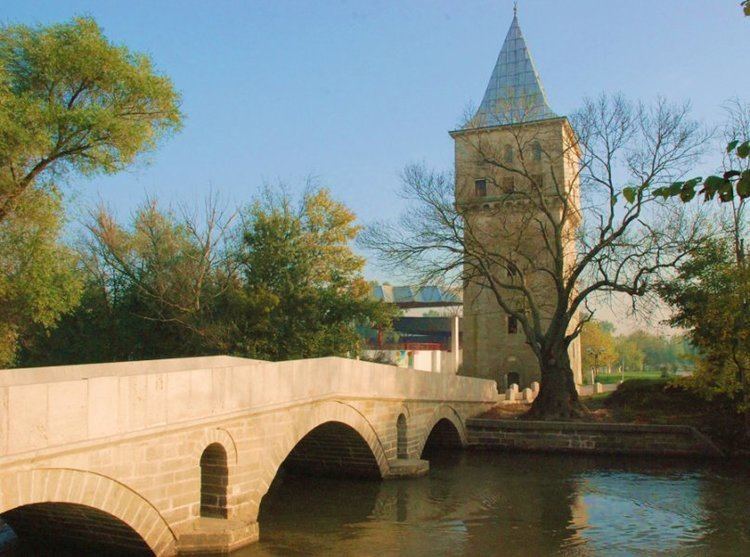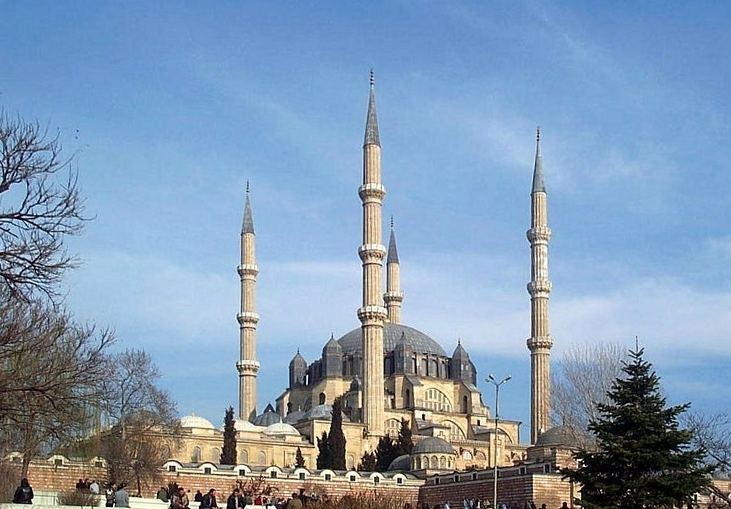Country Area 829.93 km2 Mayor Recep Gürkan (CHP) | ||
 | ||
Points of interest Selimiye Mosque, Old Mosque - Edirne, Üç ?erefeli Mosque, Bayezid II Külliye Health Museum | ||
Map of Edirne
Edirne is a city in the northwestern Turkish province of Edirne in the region of East Thrace, close to Turkey's borders with Greece and Bulgaria. Edirne served as the third capital city of the Ottoman Empire from 1363 to 1453, before Constantinople (present-day Istanbul) became the empire's fourth and final capital. The city's estimated population in 2014 was 165,979.
Contents
- Map of Edirne
- Exploring turkey edirne
- Etymology
- History
- Antiquity
- Medieval period
- Modern period
- Ecclesiastical history
- Climate
- Points of interest
- Culture
- Economy
- Universities
- High schools
- Notable people
- References

Exploring turkey edirne
Etymology

The city was founded as Hadrianopolis (Ἁδριανούπολις in Greek), named for the Roman Emperor Hadrian. This name is still used in the Modern Greek (Αδριανούπολη). The Turkish name Edirne derives from the Greek name. The name Adrianople was used in English, until the Turkish adoption of Latin alphabet in 1928 made Edirne the internationally recognized name. Bulgarian: Одрин (Odrin, ['odrin]), Albanian: Edrenë, Slovene: Одрин (Odrin) and Serbian: Једрене / Jedrene are adapted forms of the name Hadrianopolis or of its Turkish version; see also its other names.
History

The area around Edirne has been the site of no fewer than 16 major battles or sieges, from the days of the ancient Greeks. Military historian John Keegan identifies it as "the most contested spot on the globe" and attributes this to its geographical location.
Antiquity
According to Greek mythology, Orestes, son of king Agamemnon, built this city as Orestias, at the confluence of the Tonsus (Toundja) and the Ardiscus (Arda) with the Hebrus (Maritza). The city was (re)founded eponymously by the Roman Emperor Hadrian on the site of a previous Thracian settlement known as Uskadama, Uskudama, Uskodama or Uscudama. It was the capital of the Bessi, or of the Odrysians. Hadrian developed it, adorned it with monuments, changed its name to Hadrianopolis after himself (which would be corrupted into Adrianopolis, Anglicised as Adrianople), and made it the capital of the Roman province of Thrace. Licinius was defeated there by Constantine I in 323, and Emperor Valens was killed by the Goths in 378 during the Battle of Adrianople (378).
Medieval period
In 813, the city was seized by Khan Krum of Bulgaria who moved its inhabitants to the Bulgarian lands towards the north of the Danube.
During the existence of the Latin Empire of Constantinople, the Crusaders were decisively defeated by the Bulgarian Emperor Kaloyan in the Battle of Adrianople (1205). Later Theodore Komnenos, Despot of Epirus, took possession of it in 1227, but three years later was defeated at Klokotnitsa by Asen, Emperor of the Bulgarians.
In 1369, the city was conquered by the Ottoman sultan Murad I. He renamed it "Edirne".
The city remained the Ottoman capital for 90 years until 1453, when Mehmed II moved the capital to Constantinople (present-day Istanbul). Edirne is famed for its many mosques, domes, minarets, and palaces from the Ottoman period.
Modern period
Under Ottoman rule, Edirne was the principal city of the administrative unit, the eponymous Eyalet of Edirne, and after land reforms in 1867, the Vilayet of Edirne. Sultan Mehmed II, the conqueror of Constantinople, was born in Edirne. It was here that he fell under the influence of some Hurufis dismissed by Taş Köprü Zade in the Şakaiki Numaniye as "Certain accursed ones of no significance", who were burnt as heretics by a certain Mahmud Pasha.
Sultan Mehmed IV left the palace in Constantinople and died in Edirne in 1693.
During his exile in the Ottoman Empire, the Swedish king Charles XII stayed in the city during most of 1713.
Bahá'u'lláh, the founder of the Bahá'í Faith, lived in Edirne from 1863 to 1868. He was exiled there by the Ottoman Empire before being banished further to the Ottoman penal colony in Akka. He referred to Edirne in his writings as the "Land of Mystery".
Edirne was a sanjak centre during the Ottoman period and was bound to, successively, the Rumeli Eyalet and Silistre Eyalet before becoming a provincial capital of the Eyalet of Edirne at the beginning of the 19th century; until 1878, the Eyalet of Edirne comprised the sanjaks of Edirne, Tekfurdağı, Gelibolu, Filibe, and İslimye.
Edirne was briefly occupied by imperial Russian troops in 1829 during the Greek War of Independence and in 1878 during the Russo-Turkish War of 1877–1878. The city suffered a fire in 1905. In 1905 it had about 80,000 inhabitants, of whom 30,000 were Turks; 22,000 Greeks; 10,000 Bulgarians; 4,000 Armenians; 12,000 Jews; and 2,000 more citizens of non-classifiable ethnic/religious backgrounds.
Edirne was a vital fortress defending Ottoman Constantinople and Eastern Thrace during the Balkan Wars of 1912–13. It was briefly occupied by the Bulgarians in 1913, following the Siege of Adrianople. The Great Powers–Britain, Italy, France, and Russia–forced the Ottoman Empire to cede Edirne to Bulgaria at the end of First Balkan War, which created a political scandal in the Ottoman government in Istanbul (as Edirne was a former capital of the Empire), leading to the 1913 Ottoman coup d'état. Although it was victorious in the coup, the Committee of Union and Progress was unable to keep Edirne, but under Enver Pasha (who proclaimed himself the "second conqueror of Edirne", after Murad I), it was retaken from the Bulgarians soon after the Second Balkan War began.
It was occupied by the Greeks between the Treaty of Sèvres in 1920 and their defeat at the end of the Greco-Turkish War, also known as the Western Front of the larger Turkish War of Independence, in 1922.
According to the 2007 census, Edirne Province had a population of 382,222 inhabitants. The city is a thriving center of commerce for woven textiles, silks, carpets and agricultural products.
Ecclesiastical history
Adrianople was made the seat of a Greek metropolitan and of a Gregorian Armenian bishop. Adrianople is also the centre of a Bulgarian diocese, but not recognized and deprived of a bishop. The city also had some Protestants. The Latin Catholics, foreigners for the most part, and not numerous, were dependent on the vicariate-apostolic of Constantinople. At Adrianople itself were the parish of St. Anthony of Padua (Minors Conventual) and a school for girls conducted by the Sisters of Charity of Agram. In the suburb of Karaağaç were a church (Minor Conventuals), a school for boys (Assumptionists) and a school for girls (Oblates of the Assumption). Each of its mission stations, at Tekirdağ and Alexandroupoli, had a school (Minor Conventuals), and there was one at Gallipoli (the Assumptionists).
Around 1850, from the standpoint of the Eastern Catholic Churches, Adrianople was the residence of a Bulgarian vicar-apostolic for the 4,600 Eastern Catholics of the Ottoman vilayet (province) of Thrace and after 1878 - of the principality of Bulgaria. They had 18 parishes or missions, 6 of which were in the principality, with 20 churches or chapels, 31 priests, of whom 6 were Assumptionists and 6 were Resurrectionists; 11 schools with 670 pupils. In Adrianople itself were only a very few United Bulgarians, with an Episcopal church of St. Elias, and the churches of St. Demetrius and Sts. Cyril and Methodius. The last is served by the Resurrectionists, who have also a college of 90 pupils. In the suburb of Karaağaç, the Assumptionists have a parish and a seminary with 50 pupils. Besides the Eastern Catholic Bulgarians, the above statistics included the Greek Catholic missions of Malgara (now Malkara) and Daoudili (now Davuteli village in Malkara), with 4 priests and 200 faithful, because from the civil point of view belonged to the Bulgarian Vicariate.
Later however, the Roman Catholic diocese was discontinued, and exists only in name as a titular metropolitan archbishopric, under the full name Hadrianopolis in Haemimonto to distinguish it from several other titular sees named Hadrianopolis.
Climate
Edirne has a humid subtropical climate (Köppen climate classification: Cfa) with long, hot summers and cold and occasionally snowy winters.
Points of interest
Situated 7 km (4.3 mi) near to the Greek and 20 km (12 mi) to the Bulgarian border, Edirne is famed for its many mosques, domes and minarets. The Selimiye Mosque, built in 1575 and designed by Turkey's greatest master architect, Mimar Sinan (c. 1489/1490–1588), is one of the most important monuments in the city. It has the highest minarets in Turkey, at 70.90 m (232.6 ft) and a cupola 3 or 4 ft (0.91 or 1.22 m) higher than that of Hagia Sophia, the Byzantine Orthodox Cathedral (now museum) in Istanbul. Carrying the name of the then reigning Ottoman Sultan Selim II (r. 1566–1574), this mosque futures Turkish marble handicrafts, and it is covered with valuable tiles and fine paintings. Another notable mosques are Eski Cami (Old Mosque), and Burmalı Cami (Serpent Mosque), aka Üç Şerefeli Mosque.
Edirne has three historic covered bazaars: Arasta, next to Selimiye Mosque, Bedesten next to Eski Cami and Ali Paşa Çarşısı (Ali Pasha Bazaar).
Besides the mosques, there are visitor attractions in Edirne, all reflecting its rich past. The most prominent place being the Edirne Palace (Ottoman Turkish: Saray-ı Cedid-i Amire for "New Imperial Palace") in Sarayiçi quarter, built during the reign of Murad II (r. 1421–1444). Although the buildings of the palace and its bath (Kum Kasrı Hamamı) are in ruined form, the palace gate and the palace kitchen facility are restored. The Kasr-ı Adalet ("Justice Castle"), built as part of the palace complex, stands intact next to the small Fatih Bridge over the Tunca river.
Another notable building in the area is the Trakya University's Bayezid II Külliye Health Museum, an important monument with its complex construction comprising many facilities used in those times.
The Balkan Wars Memorial Cemetery is located close to the Edirne Palace, with an unknown soldier monument futuring an Ottoman soldier in front of its entrance.
The historic Grand Synagogue of Edirne, abandoned and ruined, was restored and re-opened in March 2015. A Roman Catholic and two Bulgarian Orthodox churches are found in the city.
Edirne has several historic arch bridges crossing over the rivers Meriç and Tundzha, which flow around west and south of the city.
There are caravansaries, like the Rustem Pasha and Ekmekcioglu Ahmet Pasha caravansaries, which were designed to host travelers, in the 16th century.
The historic Karaağaç railway station hosts today, after redevelopment, the Trakya University's Faculty of Fine Arts in Karaağaç suburb of Edirne. Next to it, the Treaty of Lausanne Monument and Museum are situated.
Culture
Edirne is home to the traditional oil-wrestling tournament called Kırkpınar, which is held every year in June.
Another international festival in Edirne is Kakava, a celebration of Roma people held on 5 May each year.
A cultural partnership with Lörrach in Germany has been started in 2006. The goal is to exchange pupils and students to improve their cultural skills and understanding.
Edirne is well known for the local dish "ciğer tava" (breaded and deep-fried liver) served often with cacık, diluted yogurt with chopped cucumber.
Handmade broom with mirror is one of the cultural images of the city. In old times, every bride brought a broom with mirror to her new home so it was an important part of the weddings. It is possible to see many small handmade brooms with mirror in souvenir shops.
Economy
Edirne's economy largely depends on agriculture. 73% of the working population work in agriculture, fishing, forests, hunting. There are lots of things that are cultivated here. Its lowlands are productive. The field crop cultivation has developed so much here. Corn, sugarbeet and sunflower are the first. Melon, watermelon and viniculture are advanced. For the last decade, the agricultural products have doubled. Corn, rice, sunflower, sugarbeet, tomato, eggplant, melon, watermelon, grape are cultivated so much.
The through highway with an important role in global transport that connects Europe to Middle East and Anatolian to Istanbul passes through Edirne.
Also, the existence of many historical and natural touristic places and events lead the fact that tourism has become a leading component of the economic growth of the city in recent years.
Industry has also been developing. Agriculture-based industries (agro-industries) are especially important for the city's economy.
